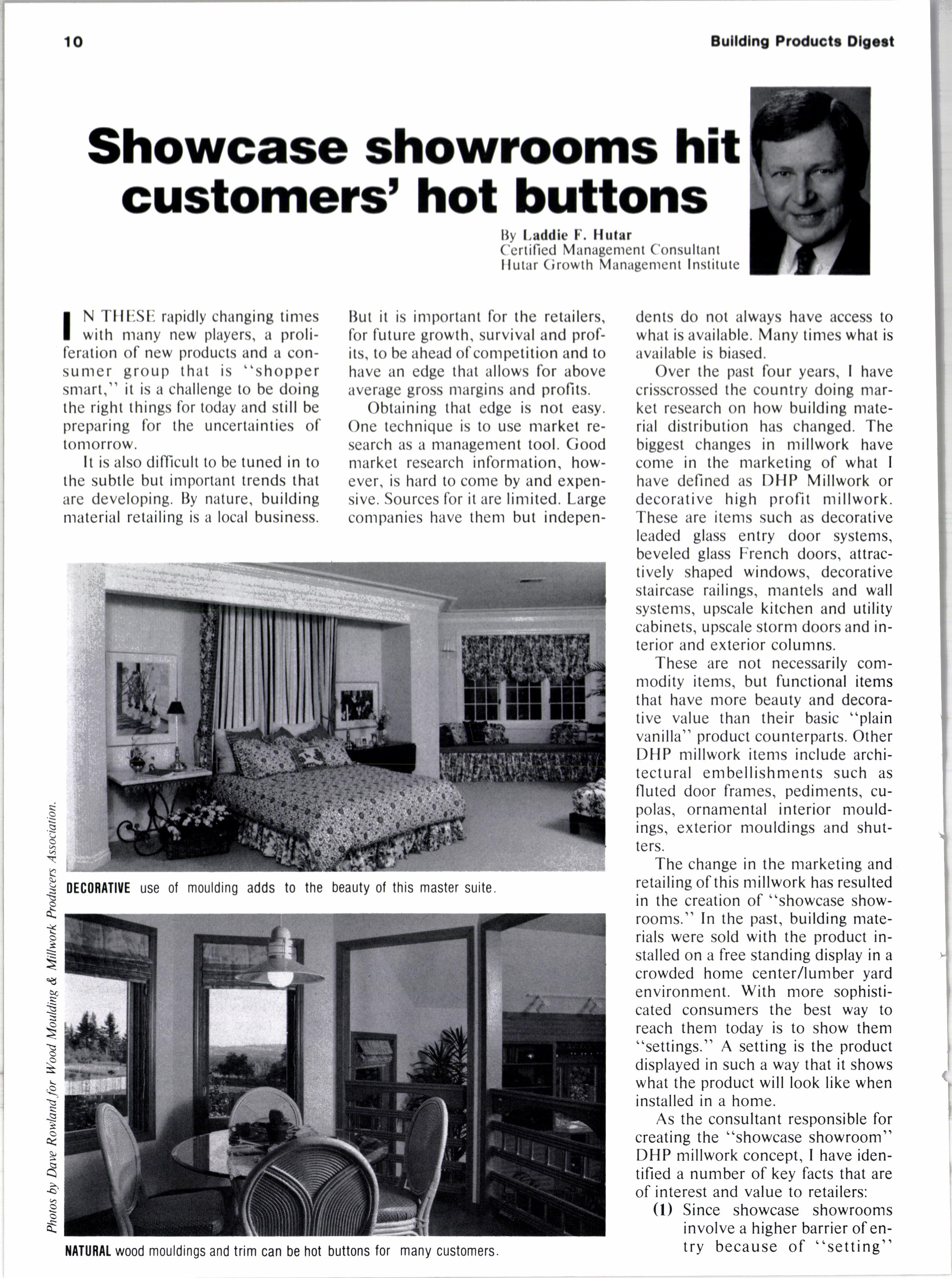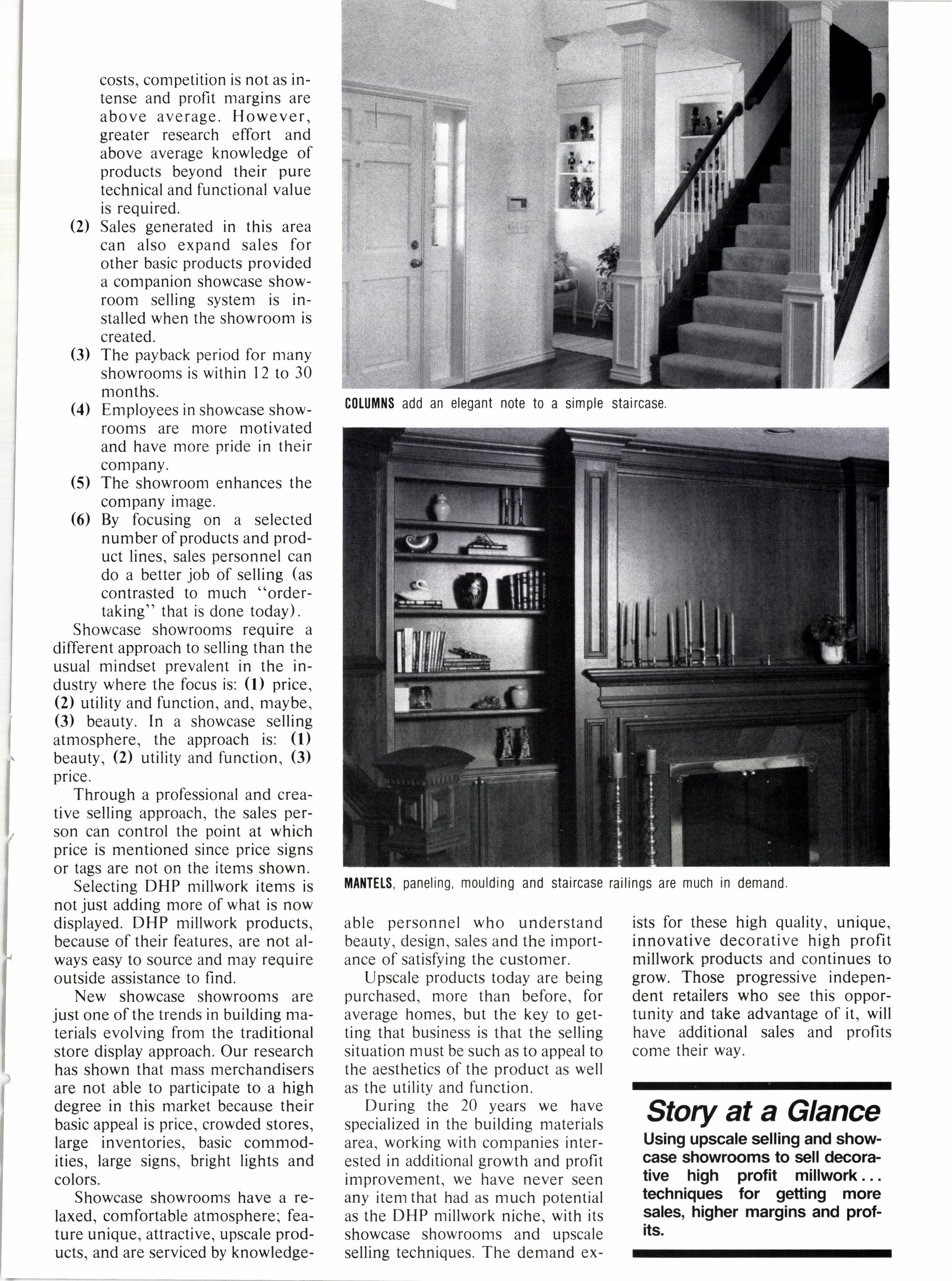
3 minute read
Showcase showrooms hit customerst hot buttons
lly l,addte F. Hutrr ('ertified Managentent ('onsultant llutar (irowth Managenrent lnstitute
I N TlltlsI: rapidly changing tinres llut it is inrportant for the retailers, for future growth, survival and profits, to be ahead o[conrpetition and to have an edge that allows for above average gross ntargins and profits.
I with nlany new players, a proliferation of new products and a consunrer group that is "shopper snlart," it is a challenge to be doing the right things for today and still be preparing for the uncertainties of tonl0rrow.
It is also difllcult to be tuned in to the subtle but inrportant trends that are developing. By nature, building nraterial retailing is a local business.
Obtaining that edge is not easy. One technique is to use nrarket research as a nranagement tool. Good nrarket research infornration, however, is hard to conre by and expensive. Sources for it are linrited. Large conrpanies have thenr but indepen- dents do not always have access to what is available. Many tinres what is available is biased.
Over the past four years, I have crisscrossed the country doing market research on how building material distribution has changed. The biggest changes in ntillwork have conre in the nrarketing of what I have defined as DHP Millwork or decorative high profit nrillwork. These are itenrs such as decorative leaded glass entry door systems, beveled glass French doors, attractively shaped windows, decorative staircase railings, nrantels and wall systenrs, upscale kitchen and utility cabinets, upscale storm doors and interior and exterior colunrns.
These are not necessarily commodity itenrs, but functional items that have nrore beauty and decorative value than their basic "plain vanilla" product counterparts. Other DHP millwork itenrs include architectural enrbellishnrents such as fluted door frames, pediments, cupolas, ornamental interior nrouldings, exterior mouldings and shutters.
The change in the nrarketing and retailing of this millwork has resulted in the creation of "showcase showrooms." In the past, building materials were sold with the product installed on a free standing display in a crowded home center/luntber yard environment. With more sophisticated consumers the best way to reach them today is to show them "settings." A setting is the product displayed in such a way that it shows what the product will look like when installed in a home.
As the consultant responsible for creating the "showcase showroom" DHP millwork concept, I have identified a number of key facts that are of interest and value to retailers:
(1) Since showcase showrooms involve a higher barrier of entry because of "setting" costs, competition is not as inLense and profit margins are above average. However, greater research effort and above average knowledge of products beyond their pure technical and functional value is required.
Sales generated in this area can also expand sales for other basic products provided a companion showcase showroom selling system is installed when the showroom is created.
The payback period for nrany showrooms is within l2 to 30 months.
Employees in showcase showrooms are more motivated and have more pride in their company.
The showroom enhances the company image.
(6) By focusing on a selected number of products and product lines, sales personnel can do a better job of selling (as contrasted to much "ordertaking" that is done today).
Showcase showrooms require a different approach to selling than the usual mindset prevalent in the industry where the focus is: (1) price, (2) utility and function, and, maybe, (3) beauty. In a showcase selling atmosphere, the approach is: (1) beauty, (2) utility and function, (3) price.
Through a professional and creative selling approach, the sales person can control the point at which price is mentioned since price signs or tags are not on the items shown.
Selecting DHP millwork items is not just adding more of what is now displayed. DHP millwork products, because of their features, are not always easy to source and may require outside assistance to find.
New showcase showrooms are just one of the trends in building materials evolving from the traditional store display approach. Our research has shown that mass merchandisers are not able to participate to a high degree in this market because their basic appeal is price, crowded stores, large inventories, basic commodities, large signs, bright lights and colors.
Showcase showrooms have a relaxed, comfortable atmosphere; feature unique, attractive, upscale products, and are serviced by knowledge- able personnel who understand beauty, design, sales and the importance of satisfying the customer.
Upscale products today are being purchased, more than before, for average homes, but the key to getting that business is that the selling situation must be such as to appeal to the aesthetics of the product as well as the utility and function.
During the 20 years we have specialized in the building nraterials area, working with companies interested in additional growth and profit improvement, we have never seen any item that had as much potential as the DHP millwork niche, with its showcase showrooms and upscale selling techniques. The demand ex- ists for these high quality, unique, innovative decorative high profit millwork products and continues to grow. Those progressive independent retailers who see this opportunity and take advantage of it, will have additional sales and profits come their way.
Story at a Glance
Using upscale selling and showcase showrooms to sell decorative high profit millwork... techniques for getting more sales, higher margins and profits.











